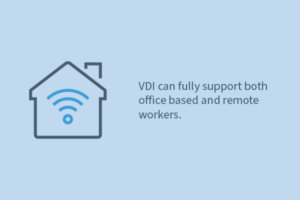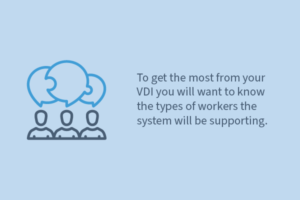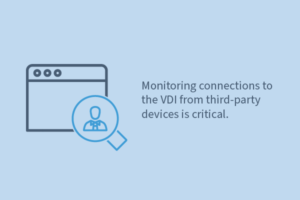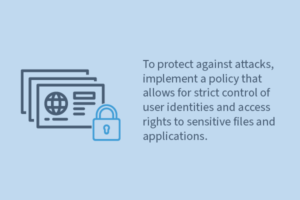If your organization is considering making the transition to virtual machines using a virtual desktop infrastructure (VDI), you want to ensure that the implementation is smooth.
 By using some established best practices, your VDI can fully support both office based and remote workers.
By using some established best practices, your VDI can fully support both office based and remote workers.
Your business will also enjoy the other primary benefits of VDI like long term cost savings, productivity enhancement, and improved security.
To get the most from virtualization:
1. Understand your users and their work patterns.
For VDI implementation to succeed, the system must completely support the users and the processing demands generated by how they work. The best practice is to start with:
• verifying the total number of users
• determining when and where they’ll work
• understanding their general requirements and work patterns.

User traffic may be random and fluctuate throughout the day. Your VDI configuration must be able to meet current usage demands while being able to adapt to future requirements.
To get the most from your VDI you will want to know the types of workers the system will be supporting. Knowledge workers create different demands than productivity workers.
Understanding who is working, how they’re working, and when will also help you determine what types of applications will be running at any given time.
2. Be mindful of your organization’s endpoints.
VDI lets organizations deliver a consistent desktop experience regardless of device type. That makes it especially important when considering bring your own device (BYOD) policies. VDI is device agnostic, but different users may have different resources, and those resources may change throughout the work day.
How can you ensure that devices and users can be controlled from any location? To begin, identify the devices you plan to support for accessing VDI.
 Once you’ve identified the device types, determine how you will secure them. For example, you might set up clear guidelines that specify which activities are allowed and which aren’t while using the company VDI.
Once you’ve identified the device types, determine how you will secure them. For example, you might set up clear guidelines that specify which activities are allowed and which aren’t while using the company VDI.
Monitoring connections to the VDI from third-party devices is critical. This will ensure anyone trying to enter the network is following your established security procedures designed to prevent data breaches.
3. Implement policies that put security first.
With the post pandemic work hybrid environment, there will continue to be more opportunities for cyberattacks. Therefore, companies need to take steps to protect their networks from these attacks. By using VDI, it allows organizations to securely access applications and data from any device at any time.
VDI also provides additional security benefits because it isolates each user’s session from others, which reduces the risk of malware spreading through shared resources.
 Plus, if your virtual machines are routed through an off-site data center, you benefit from the security protocols of the cloud provider’s data security and compliance requirements.
Plus, if your virtual machines are routed through an off-site data center, you benefit from the security protocols of the cloud provider’s data security and compliance requirements.
To protect against attacks, implement a policy that allows for strict control of user identities and access rights to sensitive files and applications.
This is especially critical in highly regulated industries such as healthcare and financial services.
Your VDI should be configured to ensure that systems are encrypted at all times and that all users are trained to use strong passwords.
Consider educating users about safe computing habits and providing them with tools to help keep themselves – and company data – secure when working remotely.
4. Rely on Experts to Implement the Right Solution for Your Organization.
While VDI can be operated from an internally managed data center, a similar alternative is Desktop as a Service (DaaS), offered by a third-party vendor.
A hosting partner is responsible for managing multiple companies’ systems. Because computing solutions is their business, a cloud service vendor’s operations use the most cutting-edge security protocols. Subscribing to such a service means you benefit from your provider’s expertise and experience without constantly having to monitor, maintain, and upgrade security internally.
If you have an IT department, this gives them the freedom to focus on more important architecture or internal goals. And if you don’t have IT staff or rely on contracted services, you’ll benefit from outsourcing your IT needs to a team that can be available 24/7/365 for support.
How Can We Help?
The decision to move to virtual desktops can transform your business, but it’s normal to have questions about the process.
We have experience working across industries to provide cost-effective solutions that allow for secure remote access, improved productivity, and leading-edge security with 99.9% uptime.
Talk to one of our experts today and let us build your company a system that meets your goals and objectives today while supporting future growth.

